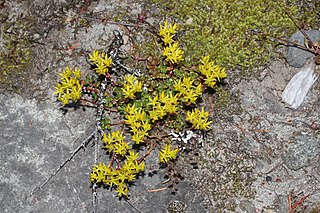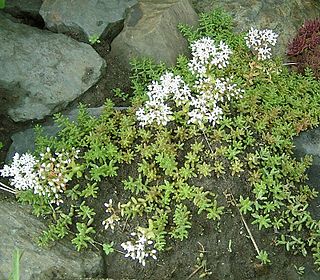
Sedum is a large genus of flowering plants in the family Crassulaceae, members of which are commonly known as stonecrops. The genus has been described as containing up to 600 species, subsequently reduced to 400–500. They are leaf succulents found primarily in the Northern Hemisphere, but extending into the southern hemisphere in Africa and South America. The plants vary from annual and creeping herbs to shrubs. The plants have water-storing leaves. The flowers usually have five petals, seldom four or six. There are typically twice as many stamens as petals. Various species formerly classified as Sedum are now in the segregate genera Hylotelephium and Rhodiola.

Sedum acre, commonly known as the goldmoss stonecrop, mossy stonecrop, goldmoss sedum, biting stonecrop and wallpepper, is a perennial flowering plant in the family Crassulaceae. It is native to Europe, but also naturalised in North America, Japan and New Zealand.

Sedum reflexum or Sedum rupestre, also known as reflexed stonecrop, Jenny's stonecrop, blue stonecrop, stone orpine, prick-madam and trip-madam, is a species of perennial succulent flowering plant in the family Crassulaceae, native to northern, central, and southern Europe. It is also known as Petrosedum reflexum.

Sedum oreganum is a species of succulent plant of the genus Sedum. It grows along the Pacific Coast of North America from Alaska to far northern California. The plant, known by the common name Oregon stonecrop, grows in many types of rocky habitat, including coastal bluffs and cliffs and the talus of higher inland mountains.
British NVC community OV39 is one of the open habitat communities in the British National Vegetation Classification system. It is one of six communities of crevice, scree and spoil vegetation.

Hylotelephium is a genus of flowering plants in the stonecrop family Crassulaceae. It includes about 33 species distributed in Asia, Europe, and North America.

Sedum album, the white stonecrop, is a flowering plant of the genus Sedum in the family Crassulaceae. It is found in the northern temperate regions of the world, often growing in crevices or free-draining rocky soil. As a long-day plant it grows vegetatively for most of the year and flowers in summer.

Sedum sexangulare, also known as tasteless stonecrop, is a species of succulent perennial and evergreen plant of the genus Sedum. It is similar to Sedum acre, but has shorter and denser leaves. It gained the binomial name ("six-angled") for its characteristic six spirals of leaves. S. sexangulare is about 15 cm (5 in) tall and is native to Europe and Asia, where it grows in the wild and is often cultivated as an ornamental plant. The plant needs wet or dry sandy soil and a sunny spot. It blooms in June and July with yellow, star-shaped flowers, which attract bees and other insects.

Sedum ternatum is the most widespread native Sedum species in eastern North America, commonly known as woodland stonecrop. It has white flowers, blooming April to May. This shade-tolerant species is often found in the forest understory, although it can also grow in sunnier locations when sufficient moisture is present. Its common name of "stonecrop" evokes its ability to thrive atop boulders, where its succulent leaves help it to retain moisture in shallow soil. It adapts well to garden use.

Sedum eastwoodiae is a rare species of flowering plant of the stonecrop Crassulaceae family. It is known by its common name Red Mountain stonecrop. It is endemic to Mendocino County, California, where it is known from only four occurrences on Red Mountain, near Ukiah. The total number of plants in existence is estimated to be around 5300. They can be found on steep, exposed, rocky mountain slopes of serpentine substrate. This species has also been treated as a subspecies of Sedum laxum.

Sedum lanceolatum is a species of flowering plant in the family Crassulaceae known by the common names spearleaf stonecrop and lanceleaf stonecrop.

Sedum spathulifolium is a species of flowering plant in the family Crassulaceae known by the common names broadleaf stonecrop, yellow stonecrop, and spoon-leaved stonecrop. An evergreen perennial, it is native to western North America from British Columbia to southern California, where it can be found often in shade in many types of rocky habitat in coastal and inland hills and mountains.

Sedum stenopetalum is a species of flowering plant in the family Crassulaceae known by the common name wormleaf stonecrop, or golden constellation. It is native to western North America from British Columbia and Alberta to northern California to Wyoming. It can be found in many types of rocky habitat, such as cliffs, talus, and steep ridges. It is a succulent plant producing mats or clumps of lance-shaped, linear, or three-lobed leaves each under 2 centimeters long. The inflorescence is a short, erect array of one to many flowers with lance-shaped petals up to a centimeter long. The petals are yellow, sometimes with red veins.

Sedum anglicum, the English stonecrop, is a species of flowering plant in the genus Sedum in the family Crassulaceae.

Sedum dendroideum, commonly known as the tree stonecrop or the false hens-and-chickens, is a shrub-like perennial plant that looks much like its Sempervivum look-alike. Native to Mexico, Sedum dendroideum plant thrives in warm, arid climates, as well as in cooler climates. It has been naturalized to California, and Ohio.

Sedum dasyphyllum, also named Sedum burnatii and commonly known as Corsican stonecrop or thick-leaved stonecrop, is a low-growing succulent flowering plant of the genus Sedum in the family Crassulaceae.

Sedum villosum, known as the hairy stonecrop or purple stonecrop, is a biennial to perennial flowering plant. Its leaves, which are 3–8 mm (0.1–0.3 in) long and may be reddish in colour, are generally covered with hairs, although S. villosum var. glabratum may have hairless leaves. Individual flowers have five pink petals, each up to 5 mm (0.2 in) long.

Phedimus kamtschaticus, the orange stonecrop, is a species of flowering plant in the family Crassulaceae. It is native to China, Korea, Japan and the Russian Far East north to Chukotka, and has been introduced to the state of New York, Norway, Germany, Austria, and the Baltic States.

Sedum praealtum, also known as shrubby stonecrop or green cockscomb is a small, woody succulent shrub in the stonecrop family that is native to Mexico.


















